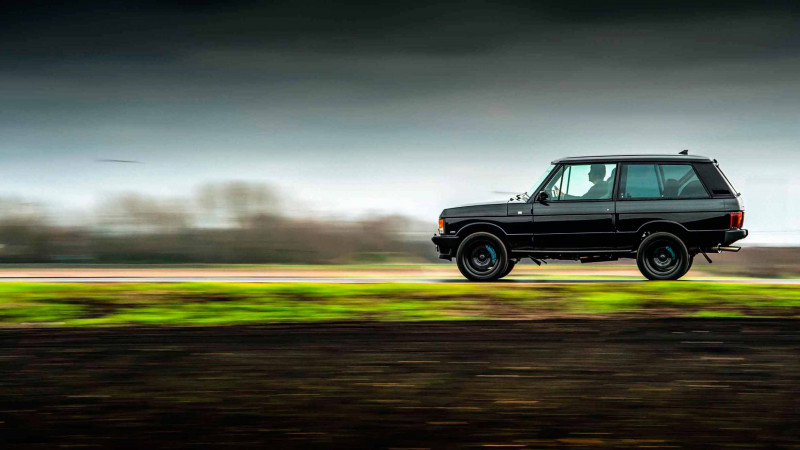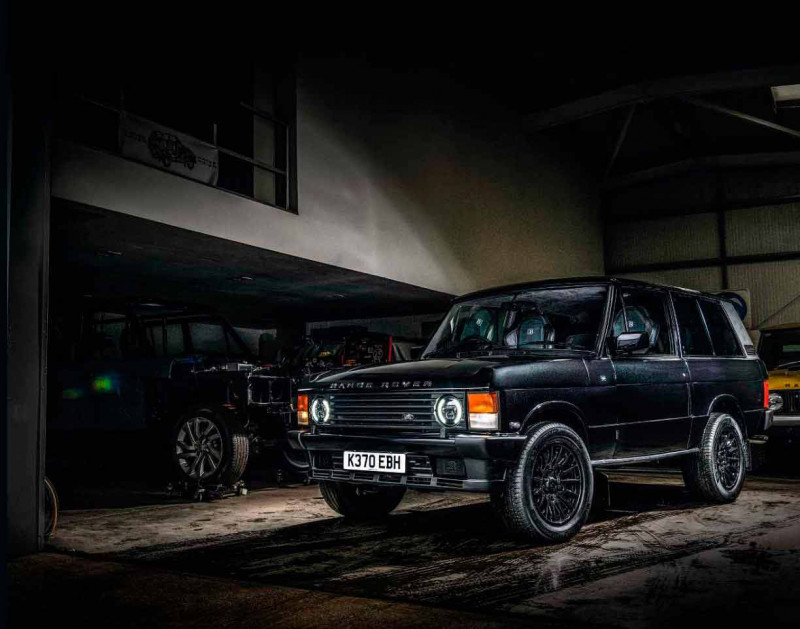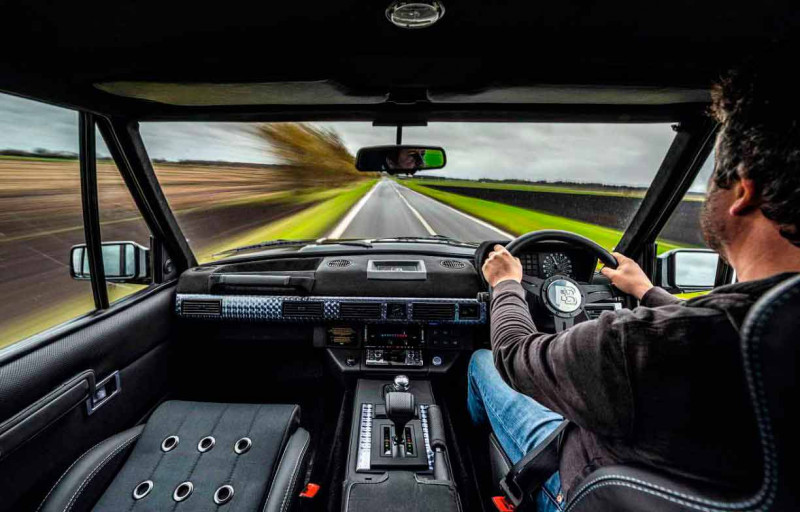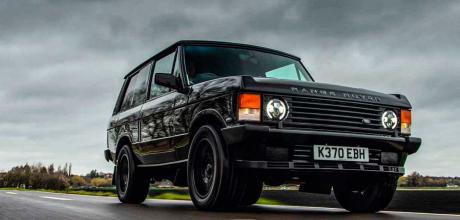Bamford X Bishops Heritage 1992 Range Rover 470bhp V8 LS3 engined
The classic Range Rover is the latest vehicle to get the restom0d treatment, thanks to a special collaboration between Bamford and Bishops Heritage.
It’s a classic two-door Rangie, but not as you know it. Richard Meaden prepares to add all 470bhp of one to his fantasy restomod garage
With the internal combustion engine nearing the end of its protracted death march, and more and more car brands announcing EV-only near-future strategies, the emotional and aspirational shift towards classic cars with modernised manners and enhanced performance grows ever stronger. As a result, where once the notion of a restomod sat firmly on the periphery, it now occupies something approaching the centre ground, providing those with the requisite cash a straight choice between brand new stock showroom offerings and something far more interesting and individual (and those less flush with folding something to dream of owning).

Of the latest restored and revitalised classics currently competing for our attention, this rather special Range Rover is an unlikely yet very appealing outlier. The product of a collaboration between cult timepiece customisers Bamford Watch Department and long-established Land Rover and Range Rover specialist Bishops Heritage, the Bamford X Bishops Heritage Limited Edition is a fusion of the latter’s time-served expertise in restoring and modifying Land Rovers and Range Rovers and the former’s trademark monochrome aesthetic and A-List following.
Limited to a run of just ten examples, each BxB Range Rover is built to order by Bishops and incorporates a full restoration along with mechanical and cosmetic enhancements, with Bishops sourcing sound examples of the classic two-door Range Rover in right- or left-hand drive according to customer requirements. The example here is based upon a 1992 car, and all ten will be built around the late, two-door, classic-shaped Rangey built between 1989 and 1993.

As with all high-end restomods, the time, expertise and bill of materials required to complete each project means the resulting asking price will seem eye-watering to some of you. But when you learn that perfectly restored standard examples of the earliest ‘Suffix A’ models are pushing £150k, it perhaps makes the £175,000 (plus VAT) asking price for the Bamford Bishops Heritage Range Rover a little easier to swallow.
Looks-wise, it remains very much true to the original Range Rover, which is a good thing in our book as you don’t want to mess with such an iconic piece of design. Modern LED head lights and black Bowler 18-inch alloys are the most explicit clues to the BxB not being a common or garden Rangie, but the square lines remain uncorrupted and are complemented by flawless Santorini Black paintwork. The dark window tints aren’t for everyone, but if you’re familiar with BWD’s signature treatment of classic Heuer, Rolex and Zenith watches, the blackout effect is very much a Bamford look.
If you associate two-door Range Rovers with utilitarian interiors, or even the traditional luxury ambience of a later Vogue model, the BxB is a startling departure. The seats in particular are an homage to 1960s racing cars, with eyelets creating a distinctly GT40 vibe. Upholstered in a mix of Nomex and supple leather, they make a bold statement that’s alien to most people’s perception of the classic Rangie, but very much in line with the performance enhancements that Bishops makes to the powertrain and chassis, which are considerable.
With 470bhp courtesy of a Chevrolet LS3 engine, the BxB is really not messing about. Retaining permanent four-wheel drive with a two-speed transfer box, there’s also a rear limited- slip differential and a six-speed torque converter automatic transmission, both to enhance response during enthusiastic driving and retain the ability to cruise comfortably on the motorway. The engine installation is impressively tidy and features detailing consistent with the rest of the car – that’s to say some neat logos and sparing use of Bamford’s trademark blue, which is also found on the brake calipers and discreet exterior badging and even informs the tone of the backlighting for the dashboard instruments.
Chevrolet engine swaps in Range Rovers are nothing new. In fact you could say that in dropping an LS motor into the engine bay Bishops has executed a retro restomod, but the combination of engine, transmission, chassis mods, far better brakes, Michelin’s finest Pilot Sport SUV rubber and Bamford’s distinctive design theme elevates this 21stcentury remake beyond any period Chevy-powered examples from back in the day.
How you respond to the results depends entirely on whether you’ve had any prior experience of early Range Rovers. If you haven’t you’ll be taken aback by how small the original model is, and by how connected to what’s going on you feel. Where today’s Range Rovers cosset and isolate you in a wafty, super-luxury driving environment packed with technology, the classic model is a much more mechanical device. Its bluff shape also generates more wind noise, but it’s worth noting the BxB is impressively devoid of the squeaks or rattles that regular classic Rangies tend to have in abundance.
In an unexpected way this Rangie is much more of an oldschool sports car in soundtrack and spirit. The V8’s presence is always felt and never unwelcome. From the pleasingly off-beat idle that lends the car a palpable pulse, to the mellow burble it emits with mild throttle openings and the good old-fashioned Hollywood car chase soundtrack when you really open the taps, this high-rise hot rod has a big and boisterous heart.

Such a surplus of power and torque means you can make effortless progress, a gentle squeeze of the throttle tapping into an impressively elastic seam of low and mid-range acceleration. But when you explore the last 30 per cent of the throttle’s travel the mood shifts, with easy-going flex switching to eye-widening punch. The transmission can be a little slow to kick down – torque converter ’boxes didn’t always behave like today’s snappy, paddle-shift autos – but there’s much to enjoy about the way this thing romps along on full noise.
Corners. Not something classic Range Rovers were designed to revel in, but something Bishops has ensured the BxB can attack with some gusto, thanks to Bilstein Ride Control electronic dampers that can be switched between pillowy soft and something approximating to firm, though all things are relative. Body roll has been largely eradicated from today’s performance cars, but despite the fitment of front and rear anti-roll bars it’s still very much a part of the BxB’s repertoire. Fear not.
It takes getting used to, especially from the elevated driving position, but once your internal gyro compensates for the angle of lean, the seat of your pants registers plenty of grip and a surprising degree of poise and balance. It’s more like a big '90s hot hatch in the way you can massage the weight transfer into and through a corner, so not only do you know where you are with it but you can make it tighten its line and even slide its tail on a closed throttle. It’s great fun and quite unlike anything else you’ll drive today.
Braking-wise, the BxB has more than enough stopping power to contain its impressive appetite for straight lines, thanks to the latest disc technology and six-pot front and fourpot rear calipers. There’s decent feel from a firm pedal, and there’s progression too, so you can make nuanced inputs with confidence and finesse. It confirms that despite what you might expect, this Rangie has what any decent performance car has; that’s to say a considered and nicely delivered consistency to the way it steers, stops and goes.
Where does it fit within the firmament of restomods? Well, it doesn’t go as far in terms of complete re-engineering as those darlings of the scene Alfaholics, Eagle or Singer, but then you wouldn’t expect, need or want a classic Range Rover to be clad in carbonfibre or hand-for med aluminium. Still, when I drift off into one of my regular Lottery win daydreams I can readily imagine a Bishops Range Rover sitting next to my GTA-R 290 or Singer DLS.
Inevitably, given the very particular nature of this car’s specification, much of the BxB’s appeal and desirability depends on whether you harbour any desire (secret or otherwise) for old Range Rovers, and of course, whether you appreciate the Bamford aesthetic. If you do, then the driving experience will only make you want it more. The performance is vivid, its delivery joyously rude when you really uncork it, but more than civilised enough when you simply want to cover some miles or mooch around town. And if you don’t dig the Bamford vibe? Like all bespoke car builders, Bishops can accommodate private commissions.
If you owned classic Rangies back in the day, or have always hankered after one but never taken the plunge, this limited run from Bamford Bishop offers as strong a case as any of the more overt evo-centric restomods. And for the price of today’s more over-the-top high-end SUVs, this leftfield choice is a far more imaginative proposition that should be on your radar.
‘WITH 470BHP COURTESY OF A CHEVROLET LS3 V8, IT REALLY ISN’T MESSING ABOUT ’



 Richard Meaden 3 years ago #
Richard Meaden 3 years ago #  Votren De Este 3 years ago #
Votren De Este 3 years ago #